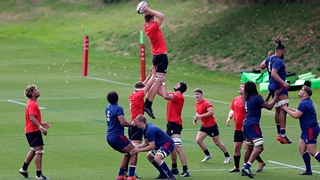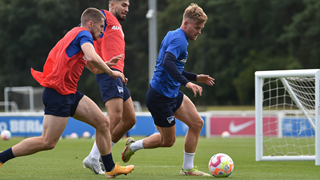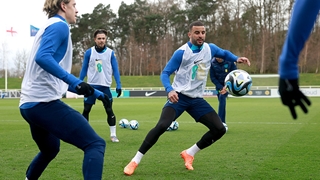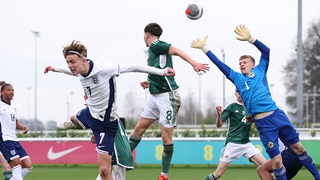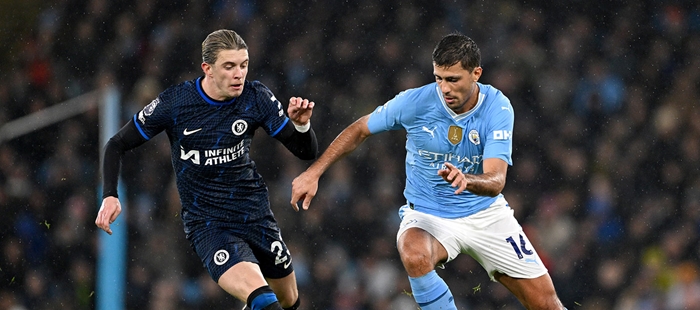
It is becoming increasingly difficult to imagine John Stones ever getting flustered. As the challenges thrown at England and Everton’s highly-rated defender increase, so too do the 21 year-old’s confidence and composure.
The latest of Stones’ challenges presented itself in the dying moments of last week’s Premier League tie against Tottenham.
With the game in the 88th minute and the score finely balanced at 1-1, a section of the home crowd let it be known that they considered the young defender’s willingness to stay on the ball - particularly in and around his own box - to go against their idea of safe and secure defending.
The flash-point emerged when the 21 year-old defender signed from Barnsley in 2013, was under intense pressure from Spurs’ attacker Heung-Min Son as the pair chased a clipped ball played towards Everton’s goal.
The Toffees’ youngster was first in the race for possession and instead of taking the easy option and anxiously kicking the ball out of play for a throw-in or a corner, Stones used a body feint to trick Son into thinking he would play the ball back down the line.
Instead, Everton’s ball-playing defender steadied himself and took a touch inside towards Tim Howard’s goal where he tempted the Spurs substitute towards him.
John Stones composure in the box
With the home crowd crying for the ball to be delivered to the back of the stand, what followed was a wonderful collection of turns – four in total – inside the penalty area, which beguiled the Tottenham attacker and led to a foul and a free-kick in the home side’s favour.
Throughout the passage of play, Stones – who was subject to a £38 million bid from Chelsea last summer- displayed the assuredness, composure, confidence and mastery of the ball which has led the young defender to be talked up as a future England great.
Stones’ style of defending is in contrast with the more traditional safety-first view many supporters demand. However, as all those around him lost their heads, Everton’s number 5 kept his, and he was quick to gesture to the home faithful to ‘calm down’ once the free-kick was awarded. Everything was under control. Even the delivery of his gestured response was done with calmness and without anger.
Stones’ interaction with the Goodison park crowd may have hinted at the defender’s desire for supporters to be more understanding of the individual and team’s style of play.
Encouraging young players to stay in possession of the ball – at all times and in all areas of the pitch – rather than aimlessly kick the ball out of play is one of the key headlines from the England DNA age-phase priorities launched last December.
The new age-related guidelines which come with the strapline ‘Love the ball, love the game’ have been designed to help coaches in their work with young players and provide a clear pathway for the development of future England internationals.
Pete Sturgess, FA Technical Lead for players aged 5-11, believes that to develop future generations of players with the technique and composure displayed by John Stones then coaches and parents of players in the grassroots game must prioritise the importance of staying on the ball.
“We need to encourage our young players to stay on the ball for longer. But this does not mean “hog the ball” or dribble until possession is lost,” explained Sturgess.
“The DNA headline ‘Stay on the ball, Master the ball’ is about giving the players the skills and confidence so they are able to keep the ball for longer regardless of the pressure from the opposition or from the lack of space available,” he explained.
By staying on the ball, players will develop their dribbling skills, their turns, twists and their spins away from pressure. The young players will become good at “hiding” the ball away from opponents and brilliant at not only knowing when to release the ball but who to release it to. These situations never occur if the player is told to pass the ball early and to the easiest option.
“If our young players can develop a greater technical capability it means they can look for more attacking, threatening and creative options rather than the easy or predictable one,” he added.
The FA’s technical lead for 5-11 is also in agreement that that the role of the crowd and the reactions of parents and coaches are crucial to creating this shift in how possession is viewed.
“This is probably the hardest for the adults to deal with let alone actively encourage and promote. It is the hardest because it will frustrate us all whilst these skills and abilities are developed.
“It is vital that we adopt a patient and consistent approach so that players feel supported when developing this aspect of their game,” said Sturgess.
Stay on the ball, master the ball: Top tips for coaches and parents:
Develop a connection with the ball
1) Coaches of players in the foundation phase [aged 5-11] must promote a real connection between the player and the ball. Young players in this phase have a desire to improve and develop their skills and are ready for this type of work.
Master the ball and body
2) Mastering the ball should include building the capability to manipulate and manoeuver the ball in any direction, at varying speeds and by using any part of the foot or body. Mastery of the ball sessions should include: dribbling, travelling with the ball, turning, receiving, shielding or screening.
A variety of decisions and formats
3) Coaches should provide a wide range of small number activities and games to ensure that the players get lots of ball contacts combined with lots of decision making.
Play Futsal
4) Futsal must be included as a game format for foundation phase players whenever possible. Futsal offers lots of repetition of situations where young players will be challenged to stay on the ball whilst also being under pressure. Exactly what is needed at this stage of development.
A positive and supportive environment
5) Coaches, parents and volunteers can all play a role in helping players get better at staying on the ball and mastering the ball. Provide a positive, encouraging and consistent environment so that players feel supported when developing this aspect of their game. It will be worth the wait.
To learn more about the England DNA age-phase priorities visit www.EnglandDNA.com



